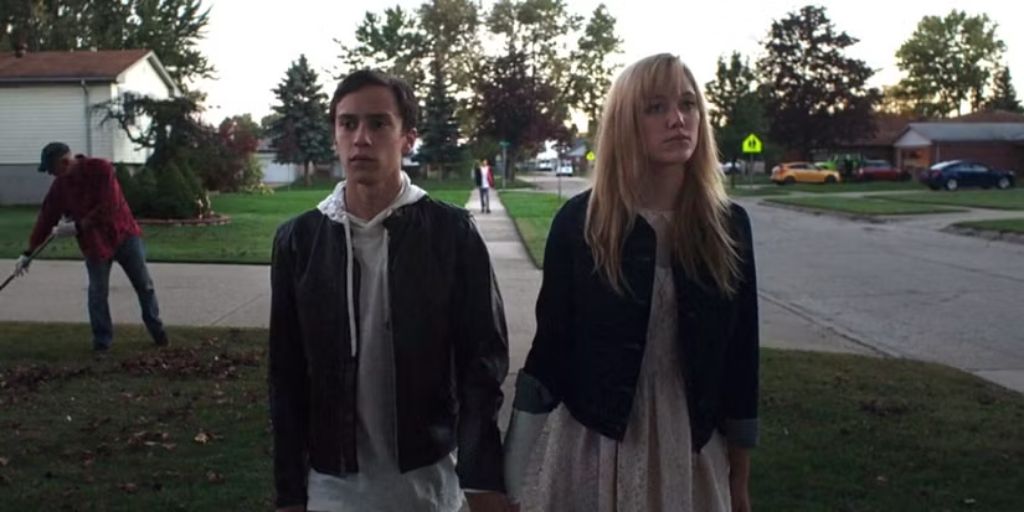
“It Follows” begins with an uneasy sense of dread. We watch a frightened teenage girl flee her suburban home for no visible reason, a scene that immediately plants uneasiness in the audience.
She ends up dead in a horrifying and unexplained manner, her body grotesquely twisted. This stark opening tells viewers that the threat in this film is both merciless and unlike anything they’ve seen before.
The movie’s central character, Jay Height, is a college-age woman living in a run-down Detroit suburb. Early in the film, she begins dating a man who introduces himself as Hugh.
During what seems like an innocent encounter, Hugh exhibits strange behaviour, nervously scanning the surroundings, uncomfortable in public spaces.
After they become intimate in his car, things take a dark turn. Jay suddenly wakes up restrained in an abandoned parking lot, with Hugh explaining the curse: a supernatural entity will now follow her, taking different human forms. It can be slow, but it never stops.
If it catches her, she will die, and the curse will return to the person before her. Jay can only “pass it on” to someone else through intimacy, but that victim, too, remains under threat if the curse ever backtracks.
Initially skeptical, Jay quickly becomes a believer when she begins seeing figures that others cannot. These figures often walk in a straight line toward her, no matter the setting. They are not always overtly monstrous, sometimes they appear as strangers, sometimes as loved ones but their presence is chilling because they close in without haste, intent on only one thing.
Seeking help, Jay turns to her sister Kelly, her friends Yara and Paul, and later her neighbor Greg. They try to rationalize the situation, only to watch it escalate.
Greg offers himself to Jay, hoping to protect her by taking on the curse. His confidence fades when he underestimates the entity. In one of the most shocking moments, the monster appears in the form of Greg’s mother and kills him brutally, proving that anyone no matter their disbelief is vulnerable.
This setup brings the group to a realization: escape may be impossible, but delaying the inevitable might be their only option.
Also Read: Infinity Pool Ending Explained, The Price of Losing Humanity
Climax: The Pool Showdown and Shattered Hopes
In desperation, the friends devise what they believe is a final, decisive plan. They lure Jay to an old, abandoned indoor pool.
The logic is grimly practical: if they can trick the entity into entering the water, they will attempt to electrocute it using powered devices like televisions, lamps, toasters, and hairdryers arranged around the edges. This scene carries a tense, almost ritualistic air, a feeling that they know they are tempting fate.
When the moment comes, the plan begins to unravel immediately. Instead of entering the pool, the entity circles the edges, using unexpected cunning.
Taking on the form of Jay’s dead father, a detail that adds a deeply personal and unsettling touch it begins hurling the electrical devices into the water, not into itself. Jay is forced to dodge them, trapped in the middle.
Paul, armed with a revolver and using a sheet to momentarily “mark” the creature’s position, tries to shoot it. His aim is shaky, and the danger grows as the entity grabs Jay’s ankle from within the pool.
After several frantic attempts, one shot hits the head. The water quickly fills with a thick, dark cloud of blood, and the creature releases Jay.
This is where the film teases a false resolution. The group pulls Jay out of the water. There’s a pause, as if the nightmare might finally be over. But there is no body left behind only the blood dispersing in the water. Viewers familiar with the rules know this doesn’t guarantee safety, and Jay and Paul seem aware of it too.
The Ambiguous Finale: Trust, Paranoia, and Endless Pursuit
The days after the incident are deliberately subdued. Jay recovers at home, showing a quiet acceptance of her situation. Paul and Jay’s relationship shifts from platonic closeness to intimacy, a moment that could either be read as genuine affection or as a calculated attempt to share the curse’s burden.
This scene is uncomfortable because it involves multiple layers vulnerability, survival instincts, and an unclear sense of responsibility.
One of the most morally complex moments comes next. Paul is shown driving through a seedy district and slowing near a group of sex workers.
The film does not explain, leaving the audience to speculate whether he approaches them to pass on the curse. Is this act an act of self-preservation, or is he trying to buy Jay more time? This ambiguity reinforces the theme of survival versus morality.
Finally, in the last sequence, Jay and Paul walk in their quiet neighborhood, holding hands. The atmosphere feels calm, perhaps even hopeful. Yet in the distance, slightly out of focus, a lone figure walks steadily in their direction.

There is no reaction from Jay or Paul; either they don’t notice, they have chosen to live with constant vigilance, or they’ve convinced themselves it’s just an ordinary person. The ambiguity of this shot leaves the audience in a state of unease, mirroring the never-ending anxiety that Jay lives with.
Themes and Psychological Impact
“It Follows” works because it takes a simple horror mechanic an unstoppable pursuer, and uses it as a metaphor for much larger fears.
The curse functions like an allegory for sexually transmitted infections, guilt, generational trauma, and even the inevitability of death. It doesn’t matter how far or fast you run; eventually, something will catch up with you.
The ending reinforces this idea. By refusing to confirm whether the entity is still approaching, director David Robert Mitchell ensures the audience experiences the same uncertainty as Jay.
The monster’s ability to take any form also deepens the paranoia. It could be the man walking toward you at the park, a stranger in the grocery store, or even someone you love.
The curse also raises moral dilemmas. Passing it on means potentially sentencing another person to death unless they, too, succeed in pushing it further down the line.
This transactional approach to survival mirrors the hard choices people make under extreme pressure choices that may not be heroic but are deeply human.
Why the Ending Stays With You
Unlike many horror films that end with a definitive victory or a shocking twist, It Follows leaves its story deliberately unresolved. Safety is never certain.
Even if Jay and Paul are alive today, they might not be tomorrow. And that’s the haunting brilliance of the film the fear doesn’t come from jump scares or loud noises, but from the idea that an unstoppable force is always, slowly, on its way.
The last walking figure in the background becomes the perfect metaphor for lingering anxiety. It might be harmless, but in the world Jay inhabits, she can never fully believe that. This transforms the film’s final image into something that sticks with viewers long after the credits roll.
By ending mid-stride, the story forces you to imagine the aftermath yourself, making the terror personal. The unknown possibility that the shadow is still closing in keeps the fear alive.
Also Read: The Witch Ending Explained, Freedom Through Dark Allegiance








